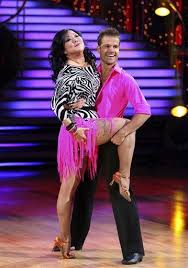Margaret Cho
 Comedian Margaret Cho continues Animal Radio's Season of the Stars lineup with her twisted take on our furry companions. She also explains how she practiced for Dancing with the Stars with her dogs.
Comedian Margaret Cho continues Animal Radio's Season of the Stars lineup with her twisted take on our furry companions. She also explains how she practiced for Dancing with the Stars with her dogs.
Margaret Cho has had dogs for about 20 years and uses them as muses, sometimes even writing about them. Her first dog Ralph was a big Shepherd Mix and was 14-years-old when he passed away. Margaret states, "He was just a wonderful, wonderful guy and I really miss him a lot!" In fact, in her CD, Cho Dependent, she dedicates her song, "Hey, Big Dog" to him. Margaret was not alone during her interview. With her were her Australian Cattle Dog Mix and Chihuahua/Pomeranian Mix.
While Margaret is known for her stand-up comedy, she also sings and is a musician, which she calls an extension of her comedy. Margaret travels a lot doing her shows, and because she sleeps with her pets, she misses them terribly when she is on the road. At home, her little Chihuahua/Pomeranian mix is adamant about the other dogs not getting on the bed! She states that having the animals on the bed with her actually helps her sleep, and when she stays in a hotel; she puts pillows on the bed to simulate having the dogs there!
Not growing up in a traditional Chinese household, Margaret was raised in San Francisco's Haight District in the 70's, where there were old hippies, ex-druggies, burnouts from the '60s, drag queens and Chinese people. However, she states that it was an amazing place to grow up in.
 Maybe some of this rubbed off on her, because even though you might not know it just by looking at her, she has many tattoos. However, most of her tattoos are not visible with her clothing, as she states, "They are mainly just for me!" Some of her tattoos include birds, horses, snakes but no dogs as of yet, even though her late dog Ralph inspired one of her horse tattoos. Margaret would take Ralph for long walks on a horse trail, and she believed he thought he was one of the horses. He really responded to them in a very magical way. And while he was a big and mighty dog, she felt he just wanted to be bigger. She thinks the best way to remember him is as a horse, because that is what he aspired to be.
Maybe some of this rubbed off on her, because even though you might not know it just by looking at her, she has many tattoos. However, most of her tattoos are not visible with her clothing, as she states, "They are mainly just for me!" Some of her tattoos include birds, horses, snakes but no dogs as of yet, even though her late dog Ralph inspired one of her horse tattoos. Margaret would take Ralph for long walks on a horse trail, and she believed he thought he was one of the horses. He really responded to them in a very magical way. And while he was a big and mighty dog, she felt he just wanted to be bigger. She thinks the best way to remember him is as a horse, because that is what he aspired to be.
Margaret loves her pets and thinks the silliest thing she does for her them is to make them toys. She takes fabric that she is not using and will make a toy where she can hide a treat inside. This gives them a new dog toy everyday that they can completely destroy! Who knows, maybe she can add dog toy maker to her resume!
Margaret is one busy lady. Besides doing stand-up, singing and acting, you might remember her when she appeared on Dancing With The Stars. While it doesn't look hard, she was wondering why she was paid such an insane amount of money to participate. But, after doing it, she states she can now see why the pay was so high. "Because it was so hard!"
Visit her website to see what she will be doing next!
Visit Website
It's Not Doggie Asthma - It's a Reverse Sneeze - Dr. Debbie
 What dog owner hasn't heard that frightening sound that dogs make - part cough, part sneeze and often described as a dog being unable to catch his breath. But it really isn't asthma, or some kind of bone stuck in your dog's throat - it's a reverse sneeze. So before you panic and run into the veterinary office on emergency, ensure you know what a reverse sneeze is.
What dog owner hasn't heard that frightening sound that dogs make - part cough, part sneeze and often described as a dog being unable to catch his breath. But it really isn't asthma, or some kind of bone stuck in your dog's throat - it's a reverse sneeze. So before you panic and run into the veterinary office on emergency, ensure you know what a reverse sneeze is.
Meet the Reverse Sneeze
A reverse sneeze is a respiratory sound in a category all its own. Also known as a pharyngeal gag reflex or backwards sneeze, the reverse sneeze is a commonly observed respiratory sound in dogs, and less commonly in cats. While a true sneeze occurs on the exhale, the reverse sneeze occurs as the dog inhales. The result is a reverberating snorting, wheezing, episodic sound that lasts for a few seconds to a minute or two. A reverse sneeze is a completely harmless sound and dogs do not suffer any immediate health threat from these episodes.
How can you tell it's a reverse sneeze?
There is no easy explanation of the sound - you just have to hear it and you'll recognize it. Click to see and hear an example of a dog's reverse sneeze episode.
Part of my enjoyment on the weekly national radio program, Animal Radio®, is describing the peculiar smells, sounds and essences of veterinary medicine with our listeners. On many an occasion when speaking to callers, I have re-created the sounds of reverse sneezing. I'm no Rich Little, but I do take pride in my impersonation of a canine reverse sneeze, which is admittedly better in person with the visuals to complement the throaty sound.
Characteristics of a dog displaying a reverse sneeze include:
- Vibrational coughing/wheezing sound
- Stiff, extended neck
- Facial grimace
- No discharge from nose
- Not followed by coughing or vomiting up material
- Not involving collapse episodes
- Animal is completely normal after event
What causes a reverse sneeze?
Some reverse sneeze episodes occur when a dog gets very excited or pulls against a leash. Brachycephalic breeds (short faced breeds) like Pugs and Boston terriers commonly display reverse sneezing due to their upper airway conformation.
 Allergies, respiratory infections, nasal mites, inhaled foreign bodies and masses can also trigger reverse sneezing. Dogs with inflammatory conditions such as lymphoplasmacytic rhinitis can also display bouts of reverse sneezing. And sometimes reverse sneezing occurs in the wee hours of the night, while a dog is sleeping, for no apparent reason. In fact, many veterinarians receive panicked phone calls at 2am from pet owners, concerned of impending asthma attacks or respiratory arrest, only to have it turn out just to be a typical case of reverse sneezing.
Allergies, respiratory infections, nasal mites, inhaled foreign bodies and masses can also trigger reverse sneezing. Dogs with inflammatory conditions such as lymphoplasmacytic rhinitis can also display bouts of reverse sneezing. And sometimes reverse sneezing occurs in the wee hours of the night, while a dog is sleeping, for no apparent reason. In fact, many veterinarians receive panicked phone calls at 2am from pet owners, concerned of impending asthma attacks or respiratory arrest, only to have it turn out just to be a typical case of reverse sneezing.
What to Do?
There is no required treatment for a reverse sneeze episode. However, I recommend stroking a dog's throat while gently speaking to him in a calm manner until the episode subsides. Some advocate closing/pinching the nostrils off, which forces a dog to swallow and curtails the reverse sneeze episode. Whatever the approach, reverse sneezing episodes are over within minutes, so no emergency treatment is indicated. Antihistamines may be prescribed to minimize reverse sneezing episodes.
When to Worry?
If all of a sudden your dog is having repeated bouts of reverse sneezing, evaluation by your veterinarian is indicated. Consult with your veterinarian if your dog is reverse sneezing along with other symptoms such as facial rubbing, nasal bleeding, nasal discharge, coughing, or significant sneezing episodes.
Nasal mites are a common cause of reverse sneezing and may be noted after a recent boarding visit, especially if multiple dogs in a household are involved. Nasal mite treatment is easily pursued with anti-parasite injections of ivermectin (or in collie breeds - the alternative Milbemycin.) If reverse sneezing is excessive and prolonged, the nasal and pharyngeal areas should be evaluated by a veterinarian through rhinoscopy - a procedure performed under anesthesia in which the nasal passages and pharyngeal areas are visualized with an endoscope, a micro camera. This is how foreign objects and masses are typically identified. In other cases, further tests may be needed including a CT scan or with biopsy samples from sinus passages.
Final Thought
The good news is that most of reverse sneezing episodes are harmless, and do not indicate any serious illness. Arm yourself with information by learning what a reverse sneeze looks like and you may save yourself an unwanted emergency veterinary visit over this peculiar but non-life threatening occurrence.
Featured veterinarian known as "Dr. Debbie" on national pet radio program, Animal Radio. Ebook author of "Yorkshire Terriers: How to Be Your Dog's Best Friend"; "Pugs: How to Be Your Dog's Best Friend"; "Mini Schnauzers: How to Be Your Dog's Best Friend"; and "Shih Tzu: How to Be Your Dog's Best Friend." Dr. Debbie's books.
Visit Website
Animal Radio News - Stacey Cohen
 Toto The State Dog?
Toto The State Dog?
One Kansas lawmaker wants to take a page from "The Wizard of Oz" and make the Cairn Terrier the state dog. That's the breed of Dorothy's dog Toto in the classic 1939 movie starring Judy Garland. Representative Ed Trimmer, who introduced the bill, joked that other lawmakers will probably bark him at the first time he takes the floor.
Ambulance For Dogs
It's the first of its kind in the state. A pet ambulance, designed to respond to emergencies for man's best friend, is now in operation in Southwest Florida. Cindy Reece's dog Dudley needed help and he needed it fast. So his veterinarian sent for the pet ambulance to get him to the emergency room as soon as possible. Southwest Florida Veterinary Services Doctor Wendy Arsenault and her husband came up with the idea. "It's piped for oxygen. Unlike a human ambulance, we actually have oxygen cages. There's an ECG, a defibrillator, blood pressure, IV fluids, catheter supplies and first aid. Pretty much everything in a human ambulance is in this ambulance," says Arsenault. It's an ambulance designed to save lives. "Time is of the essence, and the faster that you can administer that aid, the better they can do," says Arsenault. One thing that would make the ambulance better is using sirens and lights. It's something there's not permission to do just yet. But that, and even more advancements, is in the works to keep tails wagging.
 Do You Brush Your Pet's Teeth?
Do You Brush Your Pet's Teeth?
Most people brush their teeth every day, but far fewer of us remember to do the same for our pets. The American Veterinary Medical Association (AVMA) is reminding pet owners that bad breath can be a sign of serious health problems. "Periodontal disease is the most common health problem that veterinarians find in pets," explains Dr. Rene Carlson, president of the AVMA. "It's estimated that by the age of two, 80-percent of dogs and 70-percent of cats have some form of periodontal disease." The AVMA recommends that pet owners brush their pets' teeth every day, or at least several times a week. The cost of a toothbrush and pet toothpaste is far less than treatments for dental disease, which can include x-rays, teeth cleaning and tooth extraction.
 Tarzan Looking For Jane
Tarzan Looking For Jane
A former supermarket security guard is living the life of his boyhood hero. The U.K.'s Orange News says DeWet Du Toit has moved from England to Africa to live like Tarzan. The 24-year-old says he became obsessed with Tarzan as a child while living in Namibia. He now spends three nights a week living in the African jungle eating fruits and insects and hanging with the animals. Du Toit spends the rest of the week residing at his parent's home in South Africa. Du Toit is filming his life in the jungle with the hopes that he may be able to land a role in a Tarzan movie. But while he's enjoying life in the wild, Du Toit says there is something missing. He remarks, quote, "It does get lonely - I would love to find a Jane to help me pass the time."
 Listen to the entire Podcast of this show (#1033)
Listen to the entire Podcast of this show (#1033)





